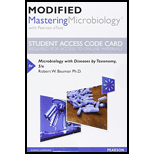
Introduction:
Bacteria are prokaryotic and unicellular organisms that either present in a cluster of cells or in isolated forms. The cell wall of bacteria is made up of peptidoglycan layer and they lack membrane-bound organelles. Bacteria can grow either in presence of oxygen (aerobes) or in the absence of oxygen (anaerobes).
Answer to Problem 1MC
Correct answer:
An aerobic bacterium can be grown in a Petri plate in laboratory conditions.
Therefore, option (b) is correct.
Option (b) is given as “an aerobic bacteria”.
Explanation of Solution
Justify the reason for the correct statement:
Bacterial cells can be cultured in the laboratory by giving them a growth media consisting required amount of nutrients and oxygen by the bacterial cell. A bacterial colony can be grown on agar medium or Petri plate. An aerobic bacterium can grow in presence of oxygen on a Petri plate containing growth medium.
Hence, option (b) is correct.
Justify the reasons for the incorrect statements:
Option (a) is given as “an anaerobic bacterium”.
Anaerobic bacterium needs maintained conditions to grow. The anaerobic bacteria grow only in the absence of oxygen and in an inoculated Petri dish that contains a seal to prevent entry of oxygen. They cannot grow in presence of oxygen in a Petri plate. Hence, it is a wrong answer.
Option (c) is given as “viruses on an agar surface”.
Viruses can grow on special growth media like bacterial cells or on tissues. They cannot be grown on agar in Petri plate. Hence, it is a wrong answer.
Option (d) is given as “all of the above”.
The aerobic bacterium can be grown on Petri plate but other options: anaerobic bacterium and viruses are incorrect as they cannot be grown on Petri plate. Hence, it is a wrong answer.
Hence, options (a), (c), and (d) are incorrect.
The aerobic bacterium which needs oxygen to grow can be cultured on growth medium in Petri plate.
Want to see more full solutions like this?
Chapter 6 Solutions
Modified Mastering Microbiology with Pearson eText -- Standalone Access Card -- for Microbiology with Diseases by Taxonomy (5th Edition)
- Which of the following takes the LONGEST to kill a live culture of vegetative bacterial cells? a) 170°C in a dry oven b) 121°C in a steaming chamber c) 100°C in a water bath d) Direct exposure to gas flamearrow_forwardwhich of the following is not a chemical method of microbial control? a. soaps and detergents b. hydrogen peroxide c. filtration d. food preservationsarrow_forwardOne of the following is INCORRECT about Spread plate a-Allow aerobic bacteria to grow b-The sample is spread on agar surface by a sterile glass spreader c-Only Surface colonies emerge after incubation d-Exclude Heat-sensitive bacteria.arrow_forward
- Would microbiology have developed more slowly if Fanny Hesse had not suggested the use of agar? Give your reasoning.arrow_forwardBacteria capable of growing on minimal media are considered which of the following? a. auxotrophs b. mediatrophs c. prototrophs d. autotrophs e. allotrophsarrow_forwardWhich of the following agents if introduced into a growing culture of bacteria would halt growth but if removed would allow growth to continue? A) Antiseptic B) Bacteriostatic agent C) Disinfectant D) Bactericidal agent E) Sterilizing agentarrow_forward
- A medium in which all the components are known is: A. Minimal medium B. Synthetic or defined medium C. Selective medium D. Complete medium E. Complex medium F. Differential medium G. General purpose mediumarrow_forwardWhich of the following statements describe a culture or molecular technique in the study of microbes? a Molecular techniques are relatively cheap. b Molecular techniques can be used for mixed cultures. c All statements are acceptable. d Microbial cultivation is costly, time requiring and labor intensive.arrow_forwardBlood agar contains intact sheep red blood cells which are used to determine if a microbe has the ability to lyse these cells. This agar is properly termed A. a selective differential medium B. a complex medium C. a differential medium and a complex medium D. a selective mediumarrow_forward
- If a student would like to examine if an bacterial organism is capable of using starch, which of the following classes of medium would the student be using? A) A medium classified as differential B) A medium classified as defined C) A medium classified as selective D) A medium classified as minimal E) A medium classified as richarrow_forwardThe Petri Dish method is used in microbiology to raise bacteria in: a) rapid growth b) pure culture c) septic environment d) all of the above 2. What is the difference between antiseptic and sanitization?3. In order to prevent any kind of contamination the medium must be _________ before placing it in the Petri dish. a) lyophilized b) pasteurized c) autoclaved d) distillearrow_forwardThe laboratory that you are working in does not have a microscope or motility medium. Now, how will you determine if a disease-causing bacterium is plants is motile or non-motile?arrow_forward
- Essentials Health Info Management Principles/Prac...Health & NutritionISBN:9780357191651Author:BowiePublisher:Cengage
 Comprehensive Medical Assisting: Administrative a...NursingISBN:9781305964792Author:Wilburta Q. Lindh, Carol D. Tamparo, Barbara M. Dahl, Julie Morris, Cindy CorreaPublisher:Cengage Learning
Comprehensive Medical Assisting: Administrative a...NursingISBN:9781305964792Author:Wilburta Q. Lindh, Carol D. Tamparo, Barbara M. Dahl, Julie Morris, Cindy CorreaPublisher:Cengage Learning


